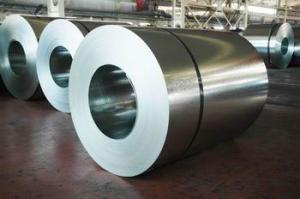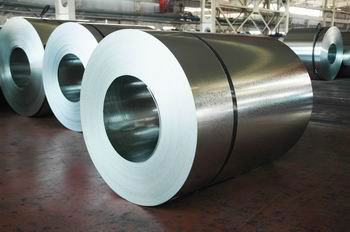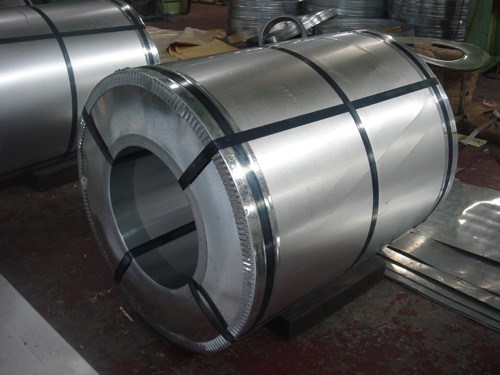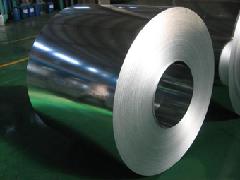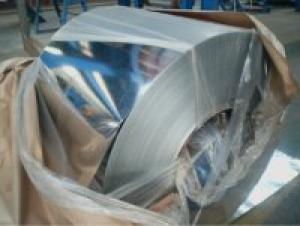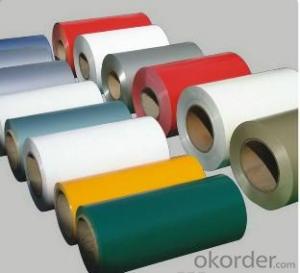GALVANIZED STEEL COIL--0.25
- Loading Port:
- China Main Port
- Payment Terms:
- TT OR LC
- Min Order Qty:
- -
- Supply Capability:
- -
OKorder Service Pledge
OKorder Financial Service
You Might Also Like
product information:
1)Operate Standard: ASTM A653M-04/JIS G3302/DIN EN10143/GBT 2518-2008
2)Grade : SGCD,SGCH, Q195,DX51D
3)Galvanized steel sheet /coil features:
4)Zinc coating :40-180g( as required)
5)width:914-1250mm(914mm, 1215mm,1250mm,1000mm the most common)
6)coil id:508mm/610mm
7)coil weight: 4-10 MT(as required)
8)surface: regular/mini/zero spangle, chromated, skin pass, dry etc.
9)application: Structural use ,roofing, commercial use, household appliance, industry, family;
special application: Wear resistant steel, high- strength - steel plate
Technical data :
Chemical Composition | ||||||
GRADE | C | Si | Mn | P | S | Ti |
SGCC/DX51D+Z | ≤0.10 | ≤0.50 | ≤0.60 | ≤0.10 | ≤0.030 | ≤0.020 |
DX52D+Z | ≤0.10 | ≤0.50 | ≤0.60 | ≤0.10 | ≤0.030 | ≤0.020 |
SGCD/DX53D+Z | ≤0.10 | ≤0.30 | ≤0.50 | ≤0.05 | ≤0.030 | ≤0.020 |
SGCE/DX54D+Z | ≤0.10 | ≤0.30 | ≤0.30 | ≤0.03 | ≤0.020 | ≤0.020 |
DX56D+Z | ≤0.10 | ≤0.30 | ≤0.30 | ≤0.03 | ≤0.020 | ≤0.020 |
Structural | ≤0.20 | ≤0.60 | ≤1.70 | ≤0.10 | ≤0.045 | |
hot dipped galvanized steel coil Mechanical Properties | |||
GRADE | Yield Strength MPa | Tensile Strength MPa | Elongation % |
SGCC(DX51D+Z) | ≥205 | ≥270 | - |
SGCD(DX53D+Z) | - | ≥270 | 38 |
SGCE(DX54D+Z) | - | ≥270 | 40 |
DX56D+Z | - | ≥270 | 42 |
- Q:I'm trying to put together a small structure using galvanized steel electrical conduit (3/4) and I can't seem to find a T-junction conduit coupler anywhere. I'm wondering if I could weld the tubing together, but I'm not sure if I can weld galvanized steel. Also, if I can weld them, is there any special technique that I need to use outside of regular acetelene/oxygen torch and solder?
- Welding Galvanized Pipe
- Q:What are the typical dimensions of a steel coil?
- The typical dimensions of a steel coil can vary depending on its purpose and industry standards. However, common dimensions for steel coils include a width ranging from 600mm to 2000mm, a coil diameter of around 1000mm to 2000mm, and a weight capacity ranging from a few tons to several dozen tons.
- Q:How are steel coils used in the production of electrical conduits?
- Steel coils are used in the production of electrical conduits as they serve as the raw material for manufacturing these conduits. The steel coils are processed and shaped into cylindrical tubes, which are then used to protect and enclose electrical wires, ensuring safe and efficient transmission of electricity.
- Q:How do steel coils contribute to the automotive aftermarket?
- Steel coils play a crucial role in the automotive aftermarket by providing the necessary raw material for manufacturing various automotive parts and components. The automotive aftermarket refers to the secondary market for vehicle parts, accessories, and services that are utilized after the original sale of the vehicle. Steel coils are used in the production of several automotive aftermarket products such as springs, suspension components, chassis parts, and body panels. These coils are typically made from high-quality steel alloys that offer the desired strength, durability, and performance characteristics required for these applications. One of the primary applications of steel coils in the automotive aftermarket is in the manufacturing of springs. Coiled springs are used in various automotive systems, including suspension systems, brakes, and clutch systems. These springs provide the necessary support, stability, and shock absorption required for smooth and safe vehicle operation. Additionally, steel coils are used in the production of chassis parts, which are important for maintaining the structural integrity and safety of the vehicle. Chassis parts made from steel coils include frame components, cross members, and reinforcement panels, which contribute to the overall stability and durability of the vehicle. Furthermore, steel coils are utilized in the production of body panels, such as doors, hoods, fenders, and roofs, which are commonly replaced or customized in the automotive aftermarket. These body panels made from steel coils not only provide aesthetic appeal but also offer protection and impact resistance. Overall, steel coils are a critical component in the automotive aftermarket as they enable the production of various parts and components that are necessary for vehicle repair, customization, and enhancement. The high strength, durability, and versatility of steel coils make them an essential raw material for meeting the demanding requirements of the automotive industry.
- Q:I am currently writing a manuscript, and would like to know whether guns made out of steel, burn or melt when exposed to flames. Thanks.
- Any steel will burn in the Presence of pure oxygen and high heat, that's how a cutting torch works.
- Q:How are steel coils inspected for paint adhesion?
- Steel coils are inspected for paint adhesion using various methods and techniques. One common method is the tape test, where a strip of adhesive tape is pressed onto the painted surface and then quickly pulled off. The tape's adhesion to the paint is then assessed by examining the amount of paint that is removed from the surface. If the paint adheres well to the steel, only a small amount of paint will be lifted off by the tape. Another method used is the crosshatch adhesion test. In this test, a series of parallel cuts are made on the painted surface using a sharp blade, creating a crosshatch pattern. A piece of adhesive tape is then applied over the cuts and quickly pulled off. The amount of paint that is removed from the crosshatched area is evaluated to determine the paint adhesion. Additionally, a visual inspection is often conducted to assess the overall appearance and adhesion of the paint. Inspectors look for any signs of cracking, peeling, or bubbling of the paint, which could indicate poor adhesion. They also check for any areas where the paint may have chipped or flaked off. Furthermore, various laboratory tests can be performed to evaluate the paint adhesion on steel coils. These tests may include techniques such as the pull-off test, where a specialized device is used to measure the force required to pull off a small section of the paint from the surface. Other tests may involve subjecting the painted surface to extreme temperature or humidity conditions to assess how well the paint holds up under different environmental factors. Overall, a combination of visual inspections, tape tests, crosshatch adhesion tests, and laboratory tests are used to thoroughly inspect steel coils for paint adhesion. These tests help ensure that the paint adheres properly to the steel surface, providing a durable and long-lasting finish.
- Q:How are steel coils used in the manufacturing of tools?
- Steel coils are used in the manufacturing of tools as they provide a strong and durable material that can be shaped and formed into various tool components. These coils are typically cut, bent, and shaped to create the desired tool design, and then further processed and treated to enhance their strength and performance. Additionally, steel coils are often used for tool handles, as they provide a sturdy grip and long-lasting durability.
- Q:How are steel coils used in the production of steel fasteners?
- Steel coils are used in the production of steel fasteners as they serve as the raw material for manufacturing various types of fasteners such as screws, bolts, nuts, and washers. The steel coils are unwound and then processed through machinery that cuts, shapes, and forms them into the desired fastener shape. This allows for efficient and precise production of steel fasteners, ensuring their strength, durability, and compatibility with various applications.
- Q:Can steel coils be coated with self-cleaning materials?
- Yes, steel coils can be coated with self-cleaning materials.
- Q:who, when and where was dual phase steel invented?
- Looking okorder /... but I would note that this stuff seems an awful lot like the techniques that have been used for making high quality swords and cutting tools for thousands of years including the famed Damacas steel. In these, the steel is heated and slowly cooled (annealed) to produce the tough matrix, then the piece is reheated and quenched to produce the hard edge. What Dual-phase seems to do is bring the process to bulk manufacture.
1. Manufacturer Overview |
|
|---|---|
| Location | |
| Year Established | |
| Annual Output Value | |
| Main Markets | |
| Company Certifications | |
2. Manufacturer Certificates |
|
|---|---|
| a) Certification Name | |
| Range | |
| Reference | |
| Validity Period | |
3. Manufacturer Capability |
|
|---|---|
| a)Trade Capacity | |
| Nearest Port | |
| Export Percentage | |
| No.of Employees in Trade Department | |
| Language Spoken: | |
| b)Factory Information | |
| Factory Size: | |
| No. of Production Lines | |
| Contract Manufacturing | |
| Product Price Range | |
Send your message to us
GALVANIZED STEEL COIL--0.25
- Loading Port:
- China Main Port
- Payment Terms:
- TT OR LC
- Min Order Qty:
- -
- Supply Capability:
- -
OKorder Service Pledge
OKorder Financial Service
Similar products
New products
Hot products
Hot Searches
Related keywords
